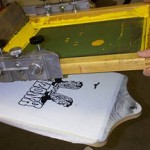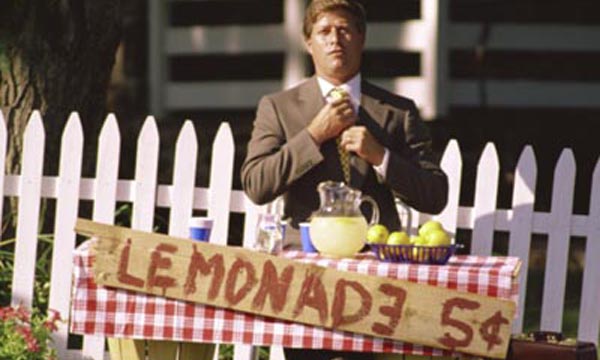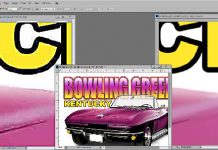 During the busy months it is important to get as much production as possible off of a manual printing press. This article details some simple steps and changes you can make to squeeze out a few more shirts and dollars per hour. Some suggestions are more long term and managerial and will take time for the changes to show in increased production. It is very important to not disregard simple changes that may only increase production by a few shirts per hour. Equate this savings by a day and month and it may be enough to pay the rent! Remember, you not only need to speed up general production, you need to reduce unnecessary downtime that decreases production!
During the busy months it is important to get as much production as possible off of a manual printing press. This article details some simple steps and changes you can make to squeeze out a few more shirts and dollars per hour. Some suggestions are more long term and managerial and will take time for the changes to show in increased production. It is very important to not disregard simple changes that may only increase production by a few shirts per hour. Equate this savings by a day and month and it may be enough to pay the rent! Remember, you not only need to speed up general production, you need to reduce unnecessary downtime that decreases production!
Managerial and Procedural Changes
- Double check the art.
There is nothing more frustrating than a production delay and screens to remake because the art was just not checked thoroughly. If you don’t have artists who know screening, then let the artists work in the shop for a week to learn about color sequence, ink buildup, mesh counts, trapping and other art/production considerations. It is much easier to spend a little extra time on the separations than to stop the presses. - Use a detailed work order.
I have been in too many shops where a work order either didn’t exist or was not used. “Print as before” becomes the norm on reorder jobs and if the production crew is new there are chances for mistakes and downtime. Why should you reinvent the wheel on a reorder? There should be notes as to color sequence, flash stations, ink considerations, job problems and more. This, along with a sample shirt from the previous run should always accompany a reorder to production. - Keep track of the little things.
You should be gathering data on all jobs including items in number 2 AND the amount of time spent on setup and teardown, rejects, screen problems and other reasons for production delays. Chart the reasons for production delays on a weekly and monthly basis to find trends. Are you having too many torn screens? Maybe your tension expectations are too high or general handling is poor. - Train the sales staff.
Try to get your sales staff to learn about screen printing. Too much time is often spent trying to print something that just doesn’t work. There are also too many sample printed without an order as the outcome. Also, there are too many redone samples with minor changes requested by the customer that are frivolous. - Keep the pressure on.
This may seem heavy handed but you need to always keep the pressure on production. If they feel that all they need to do today is one job, then one job is all that is done. If there is a schedule that is a little over optimistic it will always keep the pressure during printing, setup, teardown to get the job done because there are other jobs that need to be done too! - Have weekly meetings and job postmortem.
This is VERY important and often overlooked. Get all parties involved at the end of the week for a short meeting to go over the week’s jobs. A quick postmortem on each job will help all concerned learn from mistakes and have better communication on future jobs.
Technical and Production Floor Changes
- Use job carts for better staging.
Order staging is critical. You don’t want employees looking around for screens and ink for the next job. A simple rolling cart should be used that has all of the ink, screens, clean squeegees, and even shirts (if they will fit). If the order is too large, the shirts should be laid out on job carts by size. When a job is done, the cart is used for dirty screens, squeegees and ink. - Do regular press maintenance.
This does not have to be a big deal. If someone spends and hour every Monday morning checking registration guides, platens, dryer temperatures and other critical areas, there will be less downtime related to silly things like misprinted shirts because a little nylon bold worked loose! - Use all-arms-down press.
This will not help for short runs but can GREATLY INCREASE PRODUCTION on runs of a few hundred shirts or more. It means that you can have more than one person printing on a press at the same time. I have seen shops go from 100 4-color prints per hour to over 200 per hour by adding one more person to the production crew. Yes, it increased the body count, but we are trying to increase production in this article. There is a lot of controversy over this and many manufacturers state you don’t need it. And, in many cased you don’t/won’t need it until you have a large job with a tight deadline. And, most equipment manufacturers charge extra for this feature.
- Know your mesh and ink.
I like to say I can solve most problems with changes to “mesh and ink.” If you are hand printing, don’t be afraid to get the ink smooth and creamy. An addition of a small amount of curable reducer (not soft hand) will make the ink easier to print and will also GREATLY reduce the amount of buildup on the bottom of the screens. Also, you can go to higher mesh counts with reduced ink and get a softer hand, use less ink, reduce buildup, hold halftone dots better and on and on. For basic one-color move higher than normal and use a 156 mesh. For simple multi-color print use 156 to 200 mesh. For a detailed print with halftones use 230 mesh. For a process print use 305. - Use a push stroke with the squeegee.
Although the squeegee was designed to be pulled towards you, it is actually less fatiguing to push the squeegee away from you. It is a simple stroke that uses more of your body weight and allows for more shirts per shift. It is held at the same angle as when pulling. - Use helpers.
If you have more than one press you should have a “rover” who helps stage shirts, acts as a runner, checks to shirts coming off the dryer, helps unload and load shirts, etc. - Cross train.
Cross train all production personnel to do more than print. When there is a lull in production, they can sort and package shirts, spot shirts, clean screens and more. I am always amazed at the amount of standing around that goes on – especially if there is a production problem. Try to find self-starters who can find work to do. - Speed up setup and teardown.
This sounds so simple but it is one of the biggest time loss areas – especially on short run jobs where is may take longer to setup and teardown than to print the job.
Start by making sure that all of the above is done. Proper mesh, ink viscosity, order stages, etc. Train employees how to setup a job quickly. If necessary, go to a pin register system even on the manual presses. Standardize your screen sizes so there is very little press adjustment needed from job to job. Have good lighting over the press area and have all adjustment tools (if needed) chained to the press. Supply cut cardboard squares for scrapping a screen clean and teach people to not spend too much time in teardown. Final cleanup can be done at the screen cleaning area later.
It is the little things that count in production. Work on these items every day and find your own little time savers that equate to “free” shirts that are over and above your normal production. Good luck













